1989 MITSUBISHI GALANT steering
[x] Cancel search: steeringPage 922 of 1273

33A-1
FRONT
SUSPENSION
CONTENTSMx(AA-
LOWERARM. . . . . . . . . . . . . . . . . . . . . . . . . . . . . . . . . . . . \
. . . . . . . . . . . . . . .10
SERVICE ADJUSTMENT PROCEDURES . . . . . . .5
Front Wheel Alignment . . . .._..__._...______..__.......5
WheelBearing Adjustment . . . . . . .5
SPECIAL TOOLS. . . . . . . . . . . . . . . . . . . . . . . . . . . . . . . . . . . . \
. . . . . . . . .4
SPECIFICATIONS
. . . . . . . . . . . . . . . . . . . . . . . . . . . . . . . . . . . . \
. . . . . . . . .2
GeneralSpecifications2. . . . . . . . . . . . . . . . . . . . . . . . . . . . . . . . .
Service Specifications . . . . . . . . . . . . . .3
Torque Specifications .._...._.__.....___..............,. 3
STABILIZER BAR. . . . . . . . . . . . . . . . . . . . . . . . . . . . . . . . . . . . \
. . . . . . . . .13
STRUT ASSEMBLY. . . . . . . . . . . . . . . . . . . . . . . . . . . . . . . . . . . . \
. . . . .6
4TROUBLESHOOTING. . . . . . . . . . . . . . . . . . . . . . . . . . . . . . . . . . . . \
. .
Excessive Vehicle Rolling
Inclination of Vehicle
Noise
Poor Riding
Steering Wheel is Heavy, Vibrates
or Pulls to One Side
Page 926 of 1273
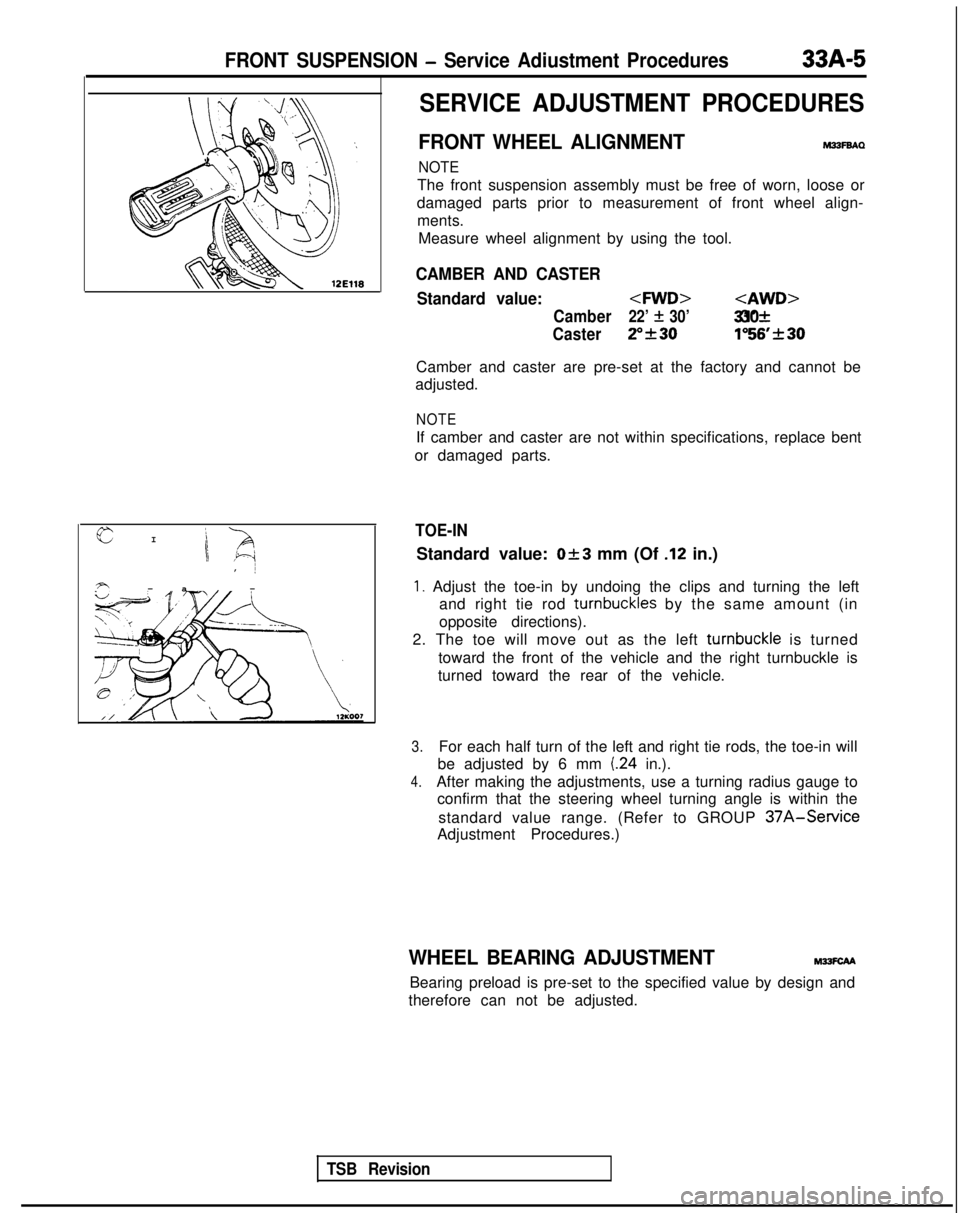
FRONT SUSPENSION - Service Adiustment Procedures33A-5
eI
-a,
-
\ ~,I 1, 1
FY
TSB Revision
SERVICE ADJUSTMENT PROCEDURES
FRONT WHEEL ALIGNMENTM33FBAQ
NOTE
The front suspension assembly must be free of worn, loose or
damaged parts prior to measurement of front wheel align- ments. Measure wheel alignment by using the tool.
CAMBER AND CASTER
Standard value:
Camber22’ f 30’ 31’& 30
Caster2”f301”56’rtr30
Camber and caster are pre-set at the factory and cannot be
adjusted.
NOTE
If camber and caster are not within specifications, replace bent
or damaged parts.
TOE-IN
Standard value: Ok3 mm (Of .12 in.)
1. Adjust the toe-in by undoing the clips and turning the left and right tie rod turnbuckles
by the same amount (in
opposite directions).
2. The toe will move out as the left turnbuckle
is turned
toward the front of the vehicle and the right turnbuckle is
turned toward the rear of the vehicle.
3.For each half turn of the left and right tie rods, the toe-in will
be adjusted by 6 mm
(24 in.).
4.After making the adjustments, use a turning radius gauge to confirm that the steering wheel turning angle is within the
standard value range. (Refer to GROUP
37A-Service
Adjustment Procedures.)
WHEEL BEARING ADJUSTMENTM?SCAA
Bearing preload is pre-set to the specified value by design and
therefore can not be adjusted.
Page 949 of 1273
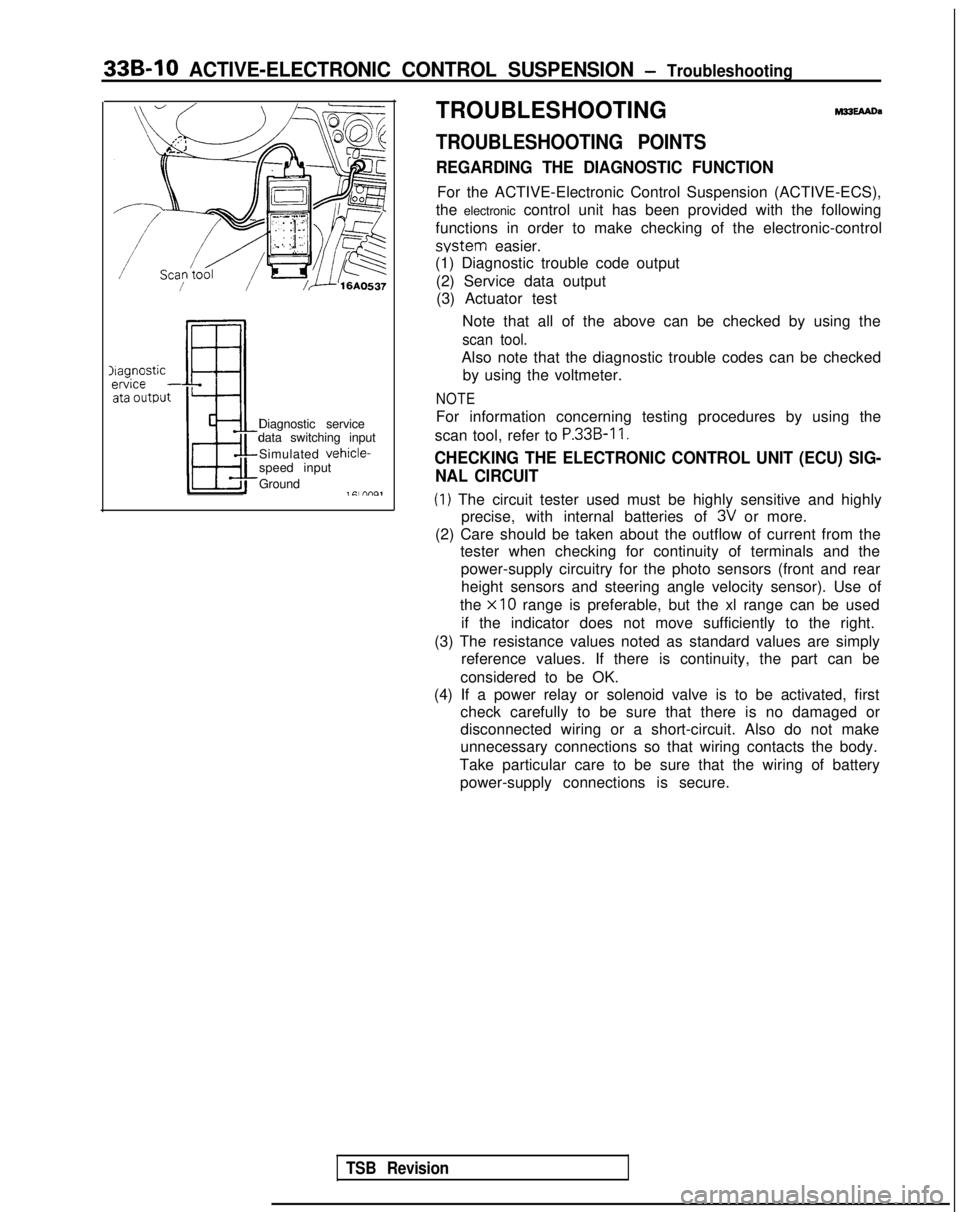
33B-10 ACTIVE-ELECTRONIC CONTROL SUSPENSION - Troubleshooting
Ifagnosticervice
- ata 0utDut
Diagnostic service
data switching input
Simulated
vehicle-speed input
Ground
1 Cl nno,
TROUBLESHOOTINGhw3EAAtm
TROUBLESHOOTING POINTS
REGARDING THE DIAGNOSTIC FUNCTION
For the ACTIVE-Electronic Control Suspension (ACTIVE-ECS),
the electronic control unit has been provided with the following
functions in order to make checking of the electronic-control system
easier.
(1) Diagnostic trouble code output
(2) Service data output(3) Actuator test
Note that all of the above can be checked by using the
scan tool.
Also note that the diagnostic trouble codes can be checkedby using the voltmeter.
NOTE
For information concerning testing procedures by using the
scan tool, refer to
P.33B-11.
CHECKING THE ELECTRONIC CONTROL UNIT (ECU) SIG- NAL CIRCUIT
(1) The circuit tester used must be highly sensitive and highly precise, with internal batteries of
3V or more.
(2) Care should be taken about the outflow of current from the tester when checking for continuity of terminals and the
power-supply circuitry for the photo sensors (front and rearheight sensors and steering angle velocity sensor). Use of
the
x10 range is preferable, but the xl range can be used
if the indicator does not move sufficiently to the right.
(3) The resistance values noted as standard values are simply reference values. If there is continuity, the part can be
considered to be OK.
(4) If a power relay or solenoid valve is to be activated, first check carefully to be sure that there is no damaged or
disconnected wiring or a short-circuit. Also do not make
unnecessary connections so that wiring contacts the body.
Take particular care to be sure that the wiring of battery power-supply connections is secure.
TSB Revision
Page 950 of 1273
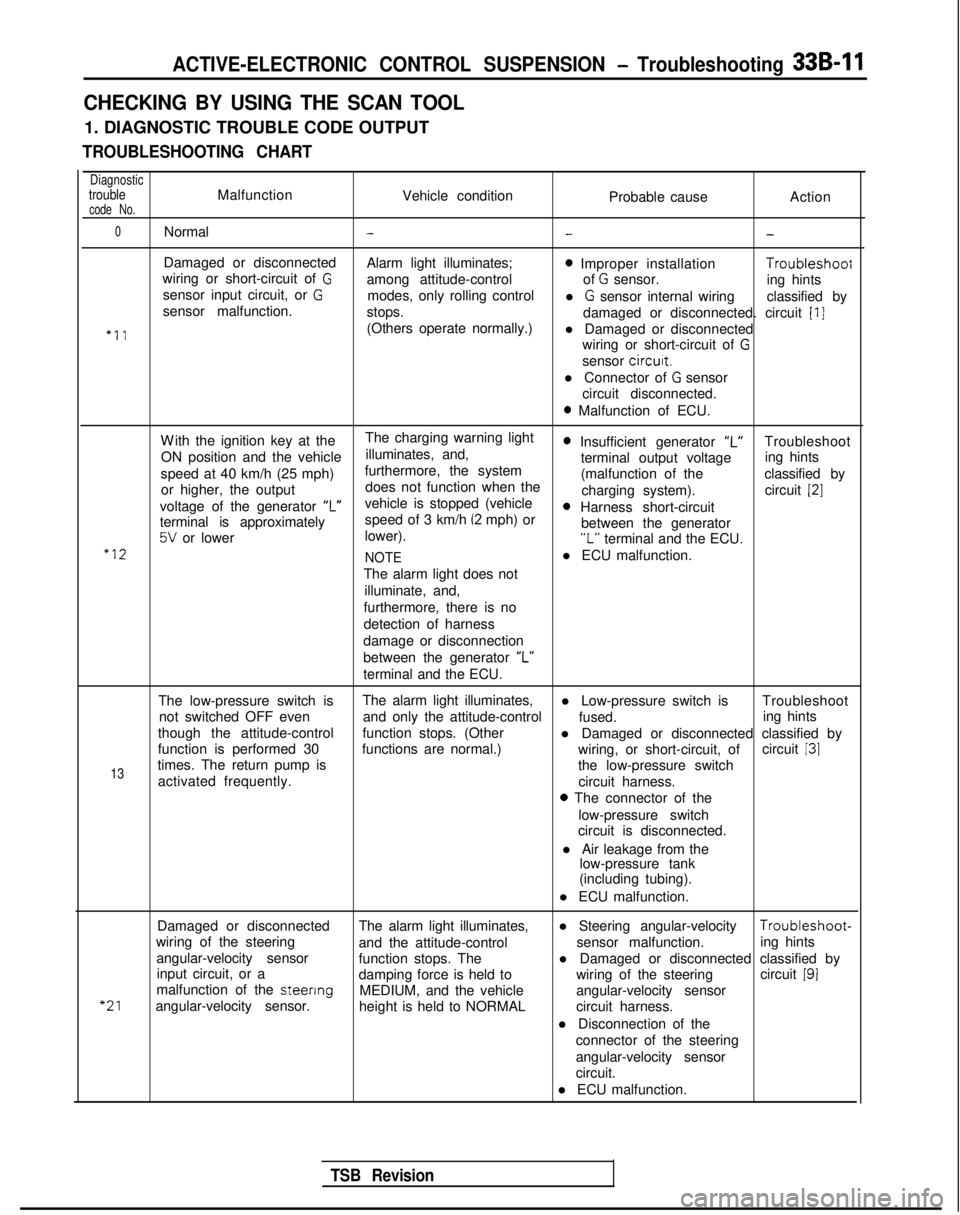
ACTIVE-ELECTRONIC CONTROL SUSPENSION - Troubleshooting 33B-11
CHECKING BY USING THE SCAN TOOL
1. DIAGNOSTIC TROUBLE CODE OUTPUT
TROUBLESHOOTING CHART
DiagnostictroubleMalfunctionVehicle conditioncode No.Probable causeAction
0Normal---
Damaged or disconnected
Alarm light illuminates;0 Improper installation Troubleshoof
wiring or short-circuit of Gamong attitude-control of G sensor.
sensor input circuit, or Ging hints
modes, only rolling control
sensor malfunction. l
G sensor internal wiring
classified by
stops. damaged or disconnected. circuit
[I]
“11(Others operate normally.)l Damaged or disconnected
wiring or short-circuit of
G
sensor circurt.
l Connector of
G sensor
circuit disconnected.
0 Malfunction of ECU.
W
ith the ignition key at the
The charging warning light
ON position and the vehicle illuminates, and,
0 Insufficient generator “L”Troubleshoot
speed at 40 km/h (25 mph) furthermore, the system terminal output voltage
ing hints
or higher, the output does not function when the (malfunction of the
classified by
charging system). circuit
[2]
voltage of the generator ‘I”vehicle is stopped (vehicle0 Harness short-circuit
terminal is approximately speed of 3 km/h (2 mph) or
5V or lower
lower). between the generator“L” terminal and the ECU.“12
NOTEl ECU malfunction.
The alarm light does not illuminate, and,
furthermore, there is no
detection of harness
damage or disconnection
between the generator “L”
terminal and the ECU.
The low-pressure switch is The alarm light illuminates,
l Low-pressure switch is Troubleshoot
not switched OFF even and only the attitude-control
fused.
though the attitude-control ing hints
function stops. (Other l Damaged or disconnected classified by
function is performed 30 functions are normal.) circuit
131
13times. The return pump is wiring, or short-circuit, of
the low-pressure switch
activated frequently. circuit harness.
0 The connector of the
low-pressure switch
circuit is disconnected.
l Air leakage from the low-pressure tank
(including tubing).
l ECU malfunction.
“21
Damaged or disconnected The alarm light illuminates,l Steering angular-velocity Troubleshoot-
wiring of the steering and the attitude-control sensor malfunction.
angular-velocity sensor ing hints
function stops. The
input circuit, or a l Damaged or disconnected classified by
damping force is held to wiring of the steeringcircuit
191malfunction of the steenng
MEDIUM, and the vehicle
angular-velocity sensor. angular-velocity sensor
height is held to NORMAL circuit harness.
l Disconnection of the connector of the steering
angular-velocity sensor
circuit.
l ECU malfunction.
TSB Revision
Page 957 of 1273
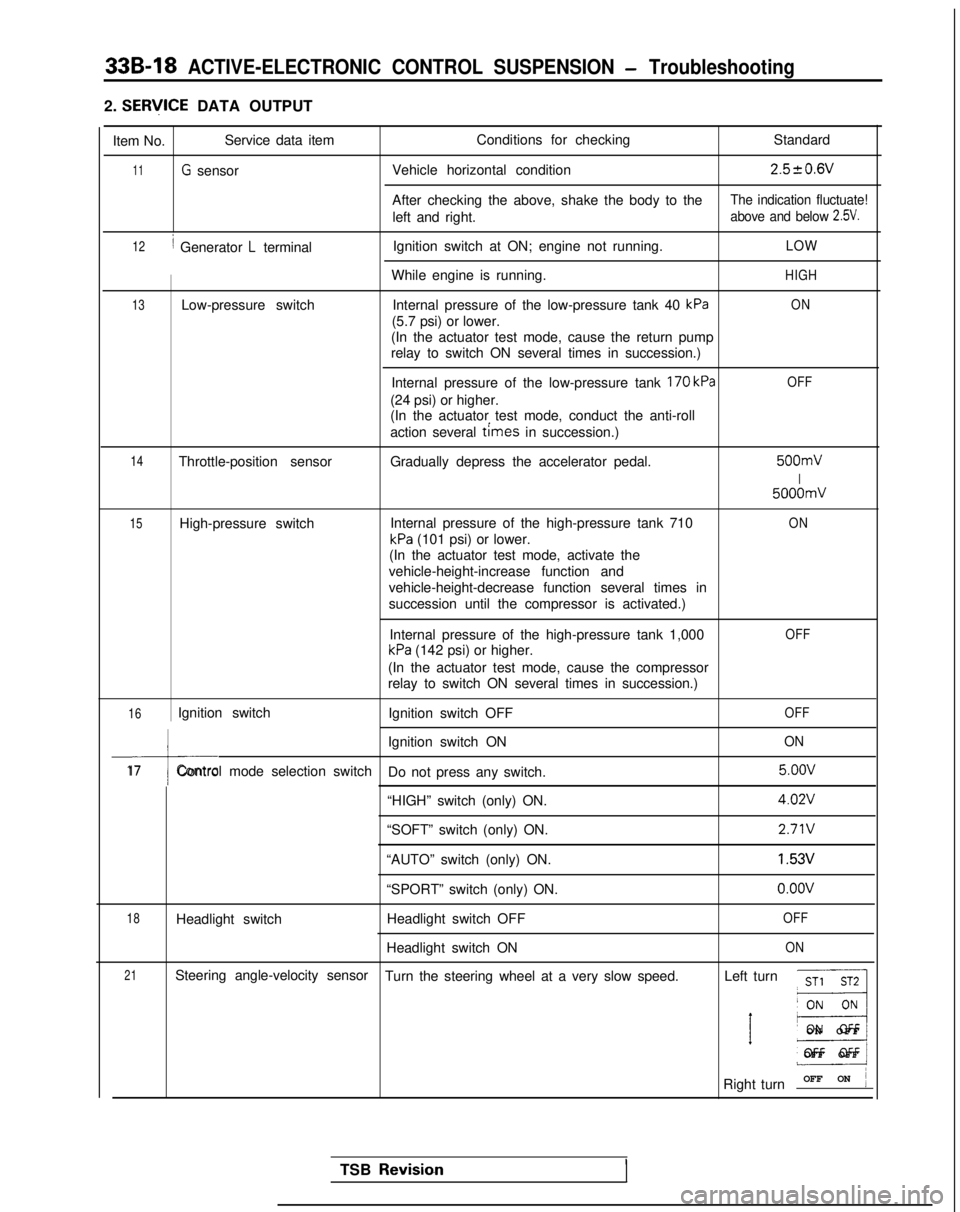
33B-18 ACTIVE-ELECTRONIC CONTROL SUSPENSION - Troubleshooting
2. SERlflCE DATA OUTPUT
Item No. Service data item
Conditions for checking
Standard
11G sensorVehicle horizontal condition2.520.6V
After checking the above, shake the body to theThe indication fluctuate!
left and right.above and below 2.5V.
12/ Generator L terminalIgnition switch at ON; engine not running.LOW
While engine is running.HIGH
13Low-pressure switch
Internal pressure of the low-pressure tank 40 kPaON
(5.7 psi) or lower.
(In the actuator test mode, cause the return pump
relay to switch ON several times in succession.)
Internal pressure of the low-pressure tank
170 kPa
(24 psi) or higher.
(In the actuator test mode, conduct the anti-roll
action several
times in succession.)
OFF
14Throttle-position sensor Gradually depress the accelerator pedal. 500mV
I
5000mV
15High-pressure switch
Internal pressure of the high-pressure tank 710ON
kPa (101 psi) or lower.
(In the actuator test mode, activate the
vehicle-height-increase function and
vehicle-height-decrease function several times in
succession until the compressor is activated.)
Internal pressure of the high-pressure tank 1,000
kPa (142 psi) or higher.
OFF
(In the actuator test mode, cause the compressor
relay to switch ON several times in succession.)
16Ignition switch Ignition switch OFFOFF
I
Ignition switch ONON
17Control mode selection switch
Do not press any switch. 5.oov
“HIGH” switch (only) ON.
4.02V
“SOFT” switch (only) ON.2.71V
“AUTO” switch (only) ON.1.53V
“SPORT” switch (only) ON.o.oov
18Headlight switch Headlight switch OFFOFF
Headlight switch ONON
21Steering angle-velocity sensor
Turn the steering wheel at a very slow speed. Left turnST1 ST2
__I
’ E3
ON OF
F
OFF OFF
Right turn OFF ON
j
TSB Revisio.nI
Page 960 of 1273

ACTIVE-ELECTRONIC CONTROL SUSPENSION - Troubleshooting 33B-21
TROUBLESHOOTING HINTS CLASSIFIED ACCORDING TO CIRCUITS
Contents
No.
PIG-sensor circuitItem
paw
P.33B-22/IPI
Generator “L” terminal circuit
P.33B-24
[31Low-pressure switch circuitP.33B-26
I41Throttle-position sensor circuitP.33B-28
[51High-pressure switch circuit P.338-30
) [6] / ACTIVE-ECS power-supply circuit
I PI IACTIVE-ECS indicators circuit
1 P.33B-32 1
1
P.33B-34 1
/ P.33B-38 1I L81 IHeadlight switch circuit
1 [9] / Steering angular-velocity sensor circuit/ P.33B-40 1
[lOI /
I
Front-height sensor circuit( P:33B-42I
PIIRear-height sensor circuit
[I21Vehicle-speed sensor circuit
[13]Rear-pressure sensor circuit
[I41 Stop light switch circuit
[I51 Back-up switch circuit
P.33B-44
P.33B46
P.33B-48 P.338-50
P.33B-52
TSB RevisionI
[If31Door switch circuitP.33B-53
[17]Damping force switching actuator drive circuit
P.338-54
1181Compressor drive circuitP.33B-561
WI
I
I
Return pump drive circuit/ P.33B-58
ml /
I
Exhaust valve actuation circuit (for vehicle-height adjustment)/ P.33B-60
I PII /Flow-rate switchover valve actuation circuit/ P.33B-62 1
I WI /Front/rear exhaust valve activation circuit1 P.33B-64 I
( 1231 1Front air-supply valve activation circuit1 P.33B-66 1
1241Rear air-supply valve activation circuitP.33B-68
[25]Left front/right front valve activation circuitP.33B-70
[=ILeft rear/right rear valve activation circuitP.33B-72
[271ACTIVE-ECS-related diagnostic/service data output circuitP.33B-74
Page 979 of 1273
![MITSUBISHI GALANT 1989 Service Repair Manual 33B-40 ACTIVE-ELECTRONIC CONTROL SUSPENSION - Troubleshooting
[9] STEERING ANGULAR-VELOCITY SENSOR CIRCUIT
\ k=3 -2
Steering angular-veloclty sensor- m0439
Photo-Interruptor B/12A0208
F-19ECU
heel
an MITSUBISHI GALANT 1989 Service Repair Manual 33B-40 ACTIVE-ELECTRONIC CONTROL SUSPENSION - Troubleshooting
[9] STEERING ANGULAR-VELOCITY SENSOR CIRCUIT
\ k=3 -2
Steering angular-veloclty sensor- m0439
Photo-Interruptor B/12A0208
F-19ECU
heel
an](/manual-img/19/57312/w960_57312-978.png)
33B-40 ACTIVE-ELECTRONIC CONTROL SUSPENSION - Troubleshooting
[9] STEERING ANGULAR-VELOCITY SENSOR CIRCUIT
\ k=3 -2
Steering angular-veloclty sensor- m0439
Photo-Interruptor B/12A0208
F-19ECU
heel
anoular- 1
F-06
pT$q
pFlz$EJ c-07
A
d2 7
I!
t
ii --
ii -I
7 aC-68
12 3
P4r _ v n
w jTT~jR-$+j 1
Steering angular-velocity sensor
-1
12AO411
TSB Revision
Page 980 of 1273
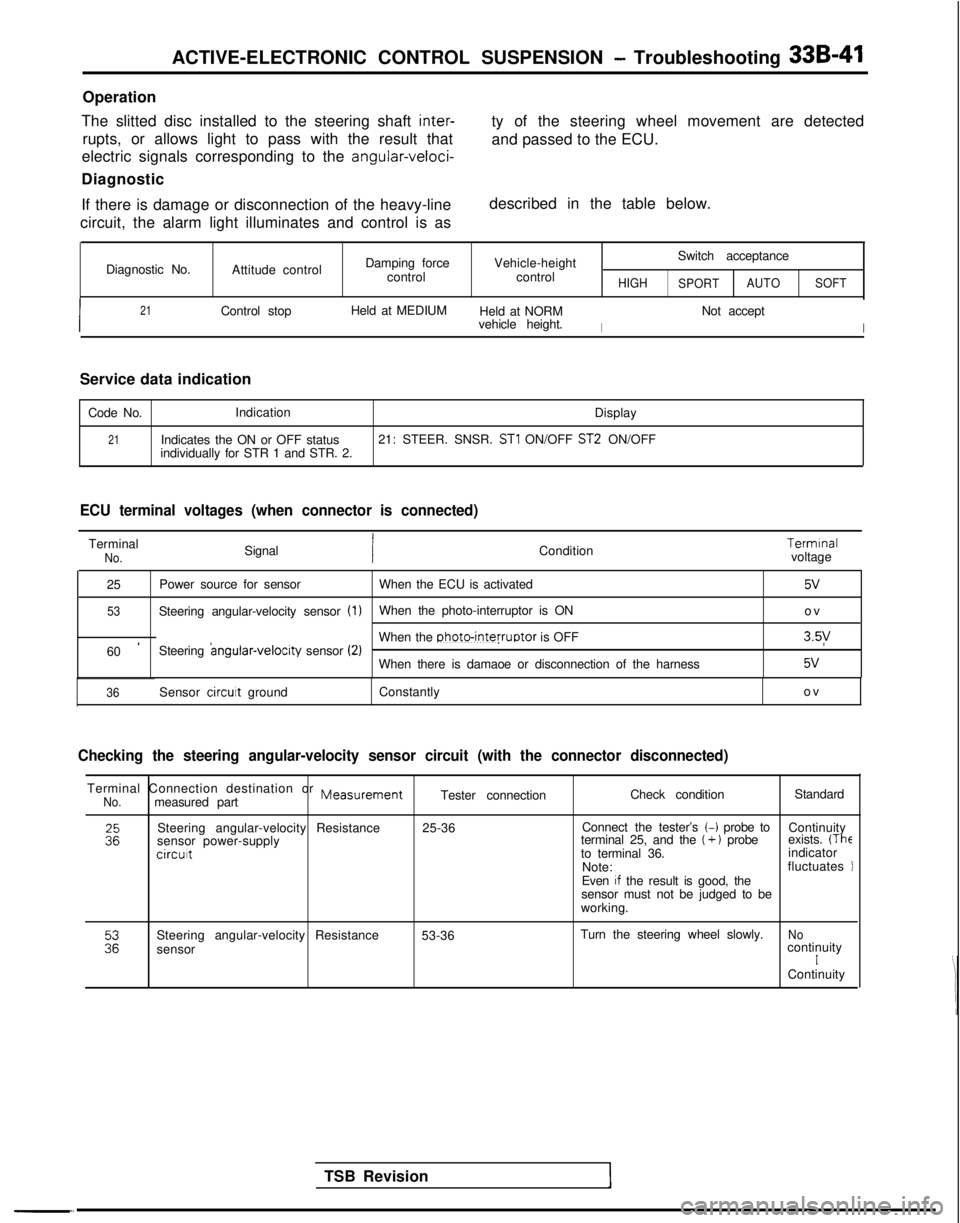
ACTIVE-ELECTRONIC CONTROL SUSPENSION - Troubleshooting 33B-41
Operation
The slitted disc installed to the steering shaft
inter-
rupts, or allows light to pass with the result that
electric signals corresponding to the
angular-veloci-
Diagnostic
If there is damage or disconnection of the heavy-line
circuit, the alarm light illuminates and control is as ty of the steering wheel movement are detected
and passed to the ECU.
described in the table below.
Diagnostic No. Attitude control Damping force
control Vehicle-height
control
HIGH
Switch acceptance
SPORT AUTO
SOFT
I
21Control stop Held at MEDIUM
Held at NORM
I
Not accept
vehicle height.
I
Service data indication
Code No. Indication
Display
21Indicates the ON or OFF status21: STEER. SNSR. ST1 ON/OFF ST2 ON/OFF
individually for STR 1 and STR. 2.
ECU terminal voltages (when connector is connected)
TerminalNo.Signal Condition Termrnal
voltage
25 Power source for sensor
When the ECU is activated
5v
53Steering angular-velocity sensor (1)When the photo-interruptor is ON
o
v
60
’Steering angular-velocrty
sensor (2)When the photo-interruptor is OFF3.5y
When there is damaoe or disconnection of the harness5v
-“.
TSB Revision
36Sensor circuit
ground Constantly ov
Checking the steering angular-velocity sensor circuit (with the connect\
or disconnected)
Terminal Connection destination or MeasurementNo.measured partTester connection
Check condition
Standard
Steering angular-velocity Resistance
sensor power-supply
circut
25-36 Connect the tester’s t-i probe to
Continuity
terminal 25, and the (+ ) probe exists. (Theto terminal 36. indicator
Note: fluctuates
Even
If the result is good, the
sensor must not be judged to be
working.
Steering angular-velocity Resistance
sensor 53-36
Turn the steering wheel slowly.
NocontinuityIContinuity